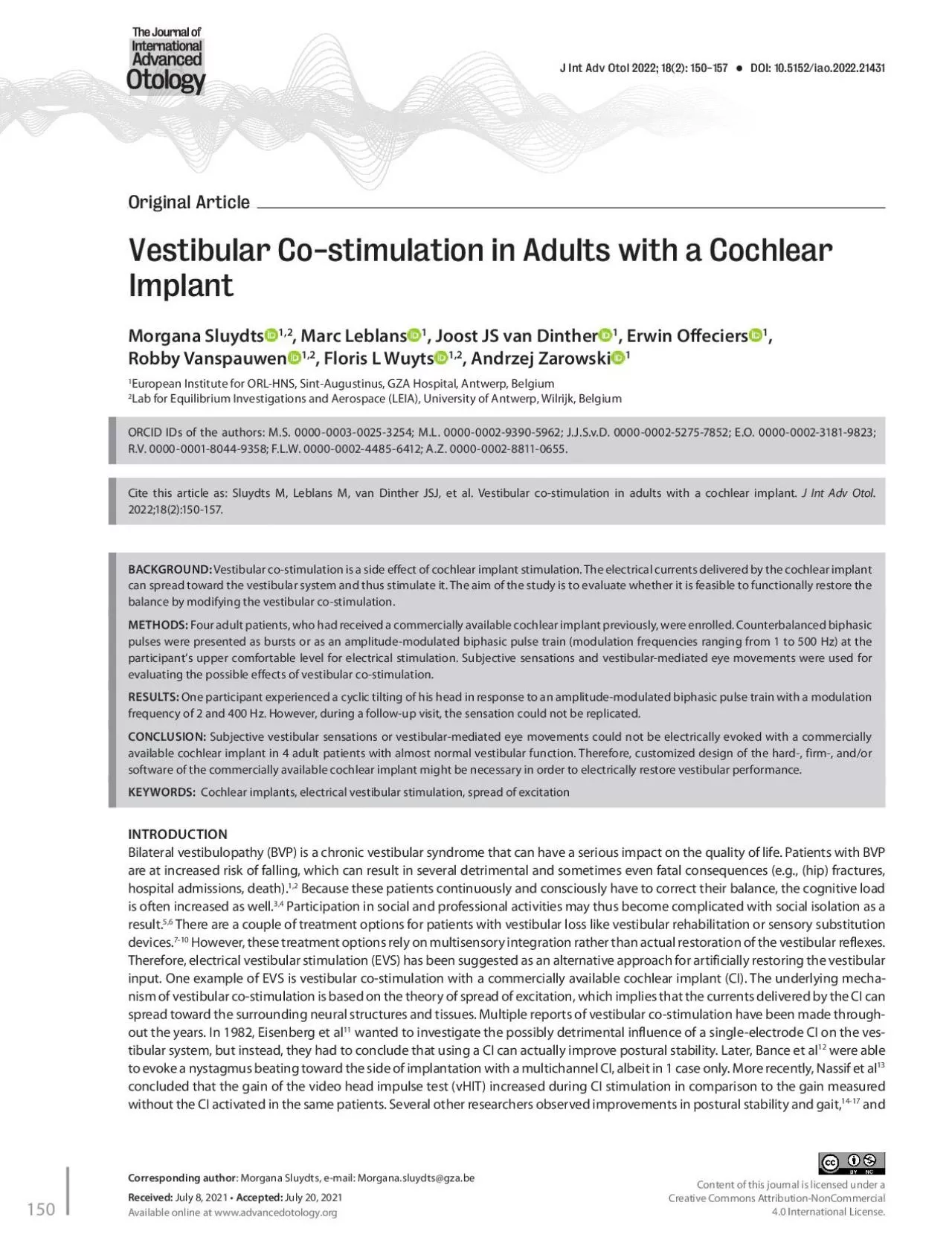

150 Marc Leblans Joost31JS van31Dinther Erwin Offeciers Robby Vanspauwen Floris31L Wuyts Andrzej Zarowski European Institute for ORLHNS SintAugustinus GZA Hospital Antwerp Bel ID: 940687
Download Pdf The PPT/PDF document "Vestibular Costimulation in Adults with ..." is the property of its rightful owner. Permission is granted to download and print the materials on this web site for personal, non-commercial use only, and to display it on your personal computer provided you do not modify the materials and that you retain all copyright notices contained in the materials. By downloading content from our website, you accept the terms of this agreement.
150 Vestibular Co-stimulation in Adults with a Cochlear ImplantMorgana Sluydts , Marc Leblans , Joost JS van Dinther , Erwin Offeciers Robby Vanspauwen , Floris L Wuyts , Andrzej Zarowski European Institute for ORL-HNS, Sint-Augustinus, GZA Hospital, Antwerp, BelgiumLab for Equilibrium Investigations and Aerospace (LEIA), University of Antwerp, Wilrijk, BelgiumORCID IDs of the authors: M.S. 0000-0003-0025-3254; M.L. 0000-0002-9390-5962; J.J.S.v.D. 0000-0002-5275-7852; E.O. 0000-0002-3181-9823; R.V. 0000-0001-8044-9358; F.L.W. 0000-0002-4485-6412; A.Z. 0000-00
02-8811-0655.Cite this article as: Sluydts M, Leblans M, van Dinther JSJ, et al. Vestibular co-stimulation in adults with a cochlear implant. J Int Adv Otol.2022;18(2):150-157.BACKGROUND: Vestibular co-stimulation is a side effect of cochlear implant stimulation. The electrical currents delivered by the cochlear implant can spread toward the vestibular system and thus stimulate it. The aim of the study is to evaluate whether it is feasible to functionally restore the balance by modifying the vestibular co-stimulation.METHODS: Four adult patients, who had received
a commercially available cochlear implant previously, were enrolled. Counterbalanced biphasic pulses were presented as bursts or as an amplitude-modulated biphasic pulse train (modulation frequencies ranging from 1 to 500 Hz) at the participant’s upper comfortable level for electrical stimulation. Subjective sensations and vestibular-mediated eye movements were used for evaluating the possible effects of vestibular co-stimulation.RESULTS: One participant experienced a cyclic tilting of his head in response to an amplitude-modulated biphasic pulse train with a modul
ation frequency of 2 and 400 Hz. However, during a follow-up visit, the sensation could not be replicated. CONCLUSION: Subjective vestibular sensations or vestibular-mediated eye movements could not be electrically evoked with a commercially available cochlear implant in 4 adult patients with almost normal vestibular function. Therefore, customized design of the hard-, firm-, and/or software of the commercially available cochlear implant might be necessary in order to electrically restore vestibular performance.KEYWORDS: Cochlear implants, electrical vestibular stimulat
ion, spread of excitationINTRODUCTIONBilateral vestibulopathy (BVP) is a chronic vestibular syndrome that can have a serious impact on the quality of life. Patients with BVP are at increased risk of falling, which can result in several detrimental and sometimes even fatal consequences (e.g., (hip) fractures, hospital admissions, death). Because these patients continuously and consciously have to correct their balance, the cognitive load is often increased as well. Participation in social and professional activities may thus become complicated with social isolation as a r
esult. There are a couple of treatment options for patients with vestibular loss like vestibular rehabilitation or sensory substitution devices. However, these treatment options rely on multisensory integration rather than actual restoration of the vestibular reflexes. Therefore, electrical vestibular stimulation (EVS) has been suggested as an alternative approach for artificially restoring the vestibular input. One example of EVS is vestibular co-stimulation with a commercially available cochlear implant (CI). The underlying mechanism of vestibular co-stimulation is bas
ed on the theory of spread of excitation, which implies that the currents delivered by the CI can spread toward the surrounding neural structures and tissues. Multiple reports of vestibular co-stimulation have been made throughout the years. In 1982, Eisenberg et al wanted to investigate the possibly detrimental influence of a single-electrode CI on the vestibular system, but instead, they had to conclude that using a CI can actually improve postural stability. Later, Bance et al were able to evoke a nystagmus beating toward the side of implantation with
a multichannel CI, albeit in 1 case only. More recently, Nassif et alconcluded that the gain of the video head impulse test (vHIT) increased during CI stimulation in comparison to the gain measured without the CI activated in the same patients. Several other researchers observed improvements in postural stability and gait, and Sluydts et al.Vestibular Co-stimulation DOI: 10.5152/iao.2022.21431Corresponding author: Morgana Sluydts, e-mail: Morgana.sluydts@gza.beReceived:Accepted:Available online at www.advancedotology.org 218 J Int Adv Otol 2022; 18(2): 150-1